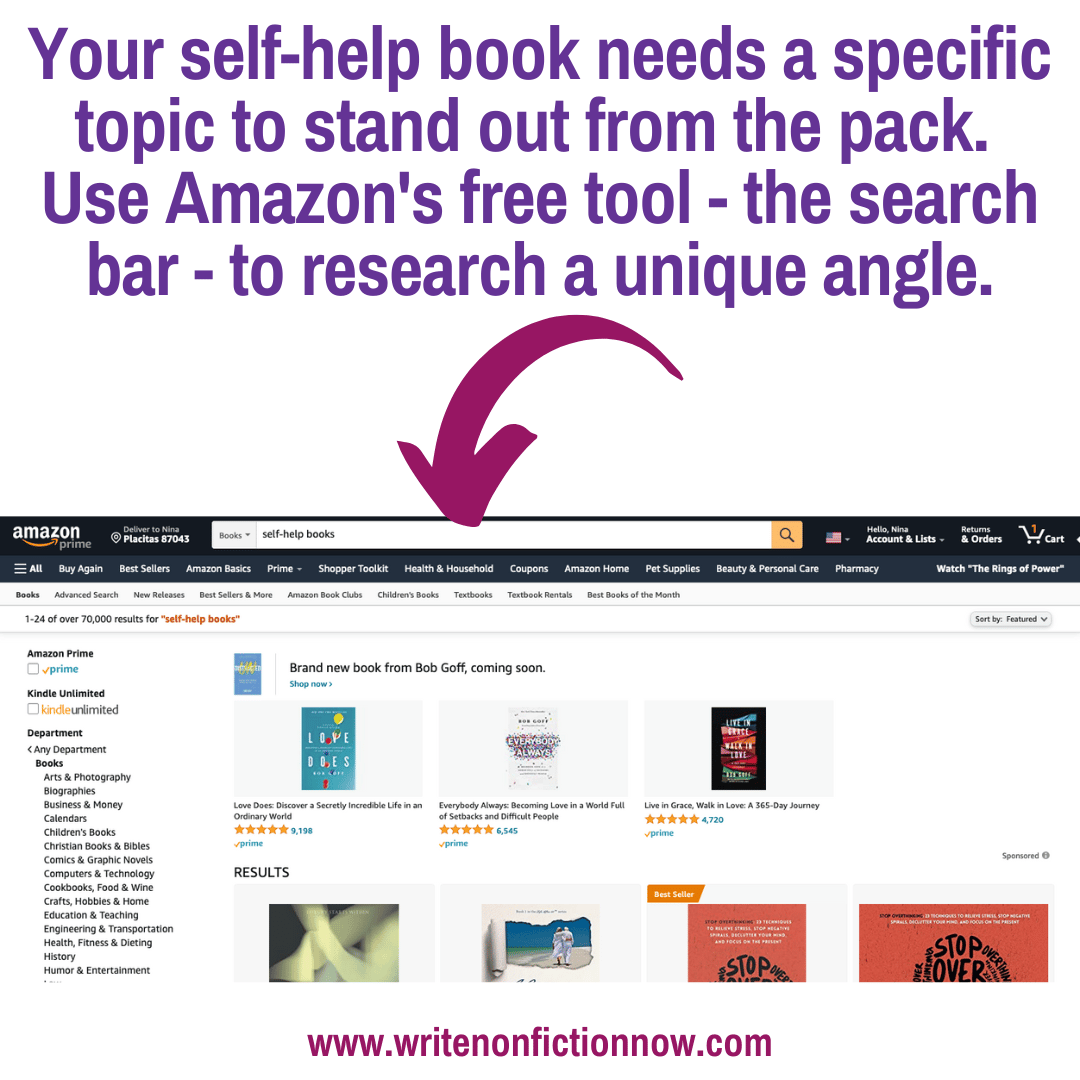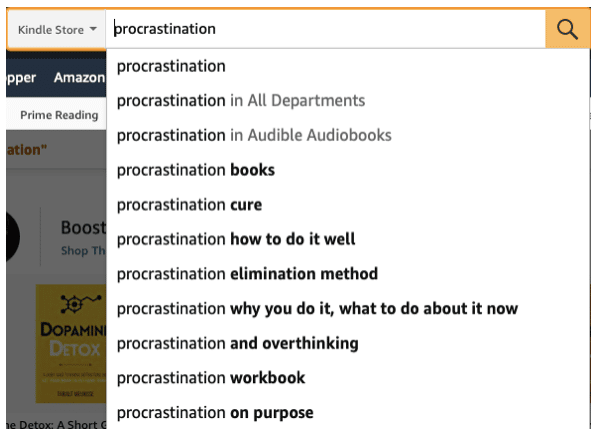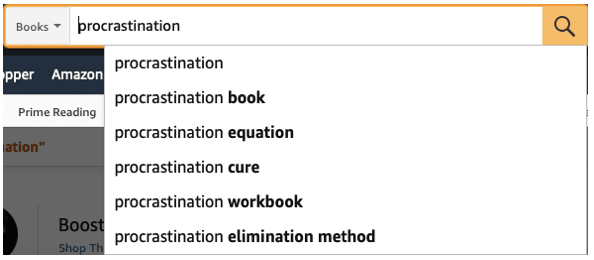Wednesday, September 7, 2022

Amazon can be an excellent tool for researching the self-help category as you decide on your book’s topic or angle. But you don’t want to waste time there. Today,
Jay Artale (
@BirdsOAFpress) explains how to effectively do self-help category and topic research using the Amazon search engine so you create a unique book your readers will find easily.
Amazon accounts for most online book sales. So it makes sense that when you’re looking for the right self-help topic for your book, you will head to the online Amazon store to do your category research.
As an author, you can initially choose book categories and keywords as part of your book set up in Amazon KDP. Once your book is published, you can add more book categories by emailing Amazon. But how many readers know about these fields or rely on them when searching for books?
Readers Inadvertently Search with Keywords
In fact, most readers use categories and keywords to search on Amazon. However, they don’t realize that’s what they are doing.
For instance, when readers go to an online book retailer, they will likely type a keyword into the search bar. And they refine their search term after they review the search results. But they probably don’t see this as a keyword search per se.
Some readers will enter a search term for a problem like procrastination. Others will search for solutions, e.g., get more done, goal setting, increase productivity, and improve focus. They simply do this out of interest—not out of a desire to do a keyword search.
Thus, when you’re using Amazon to discover a self-help category in which you want to publish, take the time to look at problems and solutions for the topic you wish to cover. This exercise helps you see multiple options for your topic and keep you away from the vastly covered broad ones.
Refine Your Self-Help Topic Based on Reader Searches
It may seem like the obvious choice to choose a broad self-help topic like procrastination. Still, this search term returns an overwhelming selection of books. Readers will refine their search to pinpoint a topic that’s more relevant to them. They may do so to find a book aimed at their demographic, to increase their understanding, or to discover solutions.
Here are some examples of books about procrastination that are targeted at specific types of readers:
- Procrastination for College Students (aimed at a specific target audience group)
- The Science of overcoming procrastination (aimed at readers who want to understand what causes procrastination)
- Overcome Procrastination – How to be More Productive and Improve Time Management (aimed at readers who are looking for a solution)
- A 10-Step Action Plan for Increasing Your Productivity (aimed at readers who are looking for an action plan solution)
Spend just 30 minutes on Amazon, and you’ll discover that each self-help topic covers a broad range of options. Resist the urge to choose a broad topic, and instead, drill down into the search results to fine-tune your subject to make it more specific.
Choose an Angle for Your Self-Help Book
There’s more than one way to write a self-help book on your chosen topic, and before you map out your chapters, take the time to determine the angle from which you want to approach the topic.
Do you want to help your reader understand the potential causes of their problem, or do you want to pitch your book as the solution?
You can, of course, cover both the problem and solution in the same book. But whichever route you choose, your book title should clarify what the reader is getting.
Write a Series on a Self-Help Topic
If you’re a subject matter expert focusing on one specific self-help topic, write a series of books on the same subject told from a different perspective or aimed at a specific demographic. This approach is better than lumping all your expertise into a single book. Additionally, this path builds a series of targeted books rather than creating one generic book.
For example, your series could include:
- A book about understanding the causes of a problem (e.g., the science or nature/nurture conditioning at the root cause)
- A book summarizing all the solutions
- Separate books going into great depth on each solution
- A workbook with action plan steps
Writing shorter books on your topic will be less overwhelming than trying to write the be-all-end-all tome. So, if you procrastinate because of overwhelm, this approach might get you writing.
To entice readers into your series, write a short book that features an overview of all the topics included in your book series. Readers will then want additional books in the series to go deeper.
Plus, this is an effective marketing tool for online promotion activities. It can also be used as a lead generator to encourage attendees to sign up for your mailing list at speaking engagements and business events.
Who is Your Reader?
When deciding on a book topic, focus on one type of person with one problem or solution. Then gut-check your category to see if you can be even more specific about who you’re targeting or what you plan on delivering.
The last thing you should aim to do is deliver generic advice that could be found on the web with a Google search. Instead, creating a target reader profile to use as your compass during the writing process is better. This profile becomes a way of keeping your content targeted and specific to your reader. When you do this, your content will be tailored to a particular reader’s needs because you know what readers really want.
After all, you want your reader to skip the generic “Overcoming Procrastination” books to discover the book that specifically targets them and their needs.
Tips for Searching on Amazon
When researching your topic on Amazon, forget about drilling down the book categories in the sidebar. Instead, focus on the search bar.
If you only have a generic search term, that’s an excellent place to start. For instance, choose Kindle Store and enter your primary topic. As you type, the most popular search terms will be displayed.

Or Book and enter your primary topic to get different results. The Amazon search bar is a useful free tool for discovering what readers are searching for.

Once you’ve selected a search term, it’s time to look at the results. Scroll past the sponsored books, and look at the rest of the search results. This helps you find books that target the same audience or angle you want to cover.
Then refine your search term to find other books that approach the topic from a similar angle.
It may feel like an exercise of trial and error. Still, the time you invest researching your category will help to refine your book’s content. And with so many self-help books out there, you need to make yours unique and appropriate for your reader.
Have you used Amazon to research your genre or category? Leave a comment below and tell me about your experience. And please share this post with a friend.
About the Author
Jay Art ale abandoned her corporate career to become a digital nomad and full-time writer. She’s an avid blogger and a nonfiction author helping travel writers and travel bloggers achieve their self-publishing goals. Join her at Birds of a Feather Press where she shares tips, advice, and inspiration to writers with an independent spirit.
ale abandoned her corporate career to become a digital nomad and full-time writer. She’s an avid blogger and a nonfiction author helping travel writers and travel bloggers achieve their self-publishing goals. Join her at Birds of a Feather Press where she shares tips, advice, and inspiration to writers with an independent spirit.
 Do you want to learn more about becoming a successful nonfiction author? Check out the Nonfiction Writers’ University. Get the education and coaching to help you succeed as a nonfiction writer. Take advantage of monthly live group author coaching, and gain access to an extensive archive of educational resources, like interviews with experts, challenges, homework assignments, courses, and ebooks. If you’ve wanted one place to go for all your nonfiction writing and publishing needs, this is it. And if you’ve wished you could purchase Nina Amir’s best courses or hire her as your author coach, now you can…for a small monthly investment. Enjoy a 30-day trial membership for only $1.
Do you want to learn more about becoming a successful nonfiction author? Check out the Nonfiction Writers’ University. Get the education and coaching to help you succeed as a nonfiction writer. Take advantage of monthly live group author coaching, and gain access to an extensive archive of educational resources, like interviews with experts, challenges, homework assignments, courses, and ebooks. If you’ve wanted one place to go for all your nonfiction writing and publishing needs, this is it. And if you’ve wished you could purchase Nina Amir’s best courses or hire her as your author coach, now you can…for a small monthly investment. Enjoy a 30-day trial membership for only $1.
Nina Amir, the bestselling author of How to Blog a Book and The Author Training Manual, is a speaker, a blogger, and an author, book, blog-to-book, and high-performance coach. Known as the Inspiration to Creation Coach, she helps creative people combine their passion and purpose so they move from idea to inspired action and positively and meaningfully impact the world as writers, bloggers, authorpreneurs, and blogpreneurs. Some of Nina’s clients have sold 300,000+ copies of their books, landed deals with major publishing houses and created thriving businesses around their books. She is the founder of National Nonfiction Writing Month, National Book Blogging Month, and the Nonfiction Writers’ University. As a hybrid author she has published 19 books and had as many as four books on the Amazon Top 100 list at the same time. Her most recent book is called Creative Visualization for Writers, and tomorrow her 19th book will be released, The Write Nonfiction NOW! Guide to Creativity and Flow. Find all her books at booksbyninaamir.com or find out more about her at ninaamir.com.